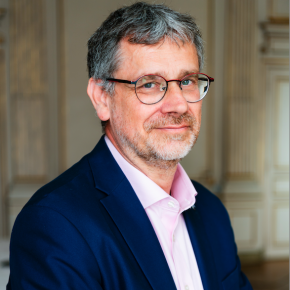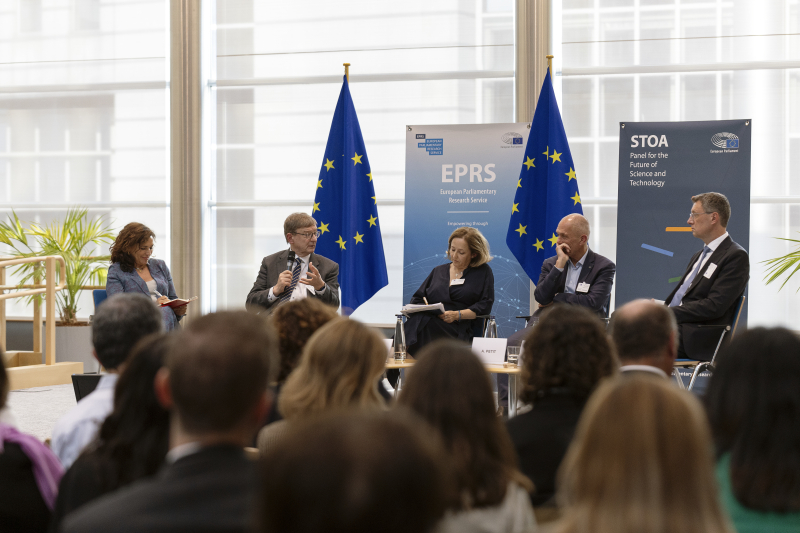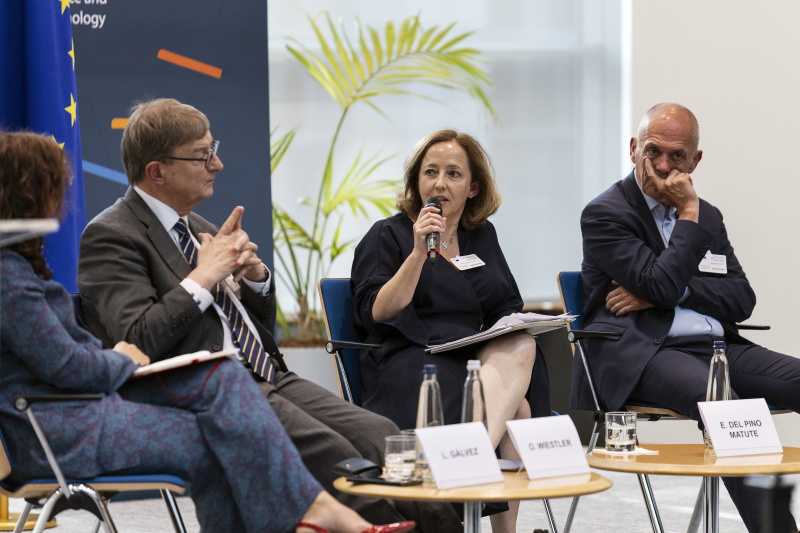Horizon Europe: “The CNRS’s voice carries importance”
On 16 July the European Commission presented its proposal that the next Framework Programme for Research and Innovation, still named Horizon Europe, be included in the 2028-2034 European Multiannual Financial Framework. An in-depth look with Jean-Stéphane Dhersin, head of the CNRS’s office abroad in Brussels.
What did you take away from the European Commission’s proposals regarding the next European framework programme, which will take effect in 2028?
Jean-Stéphane Dhersin : The CNRS is pleased by the very large budget announced–with a total of €175 billion for Horizon Europe, double that of the 2021-2027 period–and generally welcomes the initial orientations of this future framework programme, especially the preservation of basic research in Pillar 1.1 As the leading European beneficiary of the Pathfinder Open programme, the CNRS appreciates the ramping up of the European Innovation Council (EIC), a tool that is perfectly suited to the CNRS’s strategy and ties with enterprises.
With this proposal, the Commission has placed research and innovation at the heart of its vision to strengthen the EU’s competitiveness. The stated goal is to reinforce scientific excellence, especially to use the next Horizon Europe programme to enhance the EU’s technological sovereignty with investments in key areas.
The proposal sketches out a recasting of the Horizon Europe programme, with respect to both its architecture and implementation. It would enjoy partial budgetary protection, and would be based on greatly expanded funding, especially for basic research.
The CNRS is nevertheless paying attention that basic research of excellence irrigates all of the framework programme’s pillars, via clear mechanisms for a continuum between research and innovation. Concerns remain. For example, Horizon Europe would be closely linked to the European Competitiveness Fund2 (ECF) for its strategic and applied components. Pillar 2, whose largest share would be directly oriented towards the ECF, could thus favour advanced innovation projects (with high TRLs3 ) to the detriment of basic research (with low TRLs). It is crucial that work programmes preserve a balance between basic and applied research, and that their development as part of comitology remains entrusted to scientific experts.
The CNRS has provided its recommendations on the subject. Were they heard?
J-S. D. : Like many other European research organisations, the CNRS produced a position paper, and we indeed found a number of its proposals in the text presented by the Commission, especially a largely increased and shielded budget for research. The budget’s independence from the European Competitiveness Fund, which was long uncertain, was recently confirmed by the Commission President on 4 June, during an event jointly organised at the European Parliament by the G6 Network–in which the CNRS takes part on behalf of France–and the STOA panel4 (Panel for the Future of Science and Technology), which analyses scientific and technological issues that are common to member states. This budgetary independence is crucial to ensuring good representation for basic research projects, especially when competitiveness and innovation are considered a priority by the European Commission.
- 1Horizon Europe, the European Commission’s programme for research and innovation, consists of three pillars. The first, Scientific Excellence, is devoted to basic research, with the European Research Council (ERC), Marie Sklodowska-Curie Actions (MSCA), and research infrastructures. The second, Global Challenges and European Industrial Competitiveness, supports major collaborative projects, and is organised in “clusters.” It includes that largest share of funding, with 53.5 billion euros. The third pillar is the European Innovation Council (EIC).
- 2The European Competitiveness Fund (ECF) is a new budgetary instrument planned by the Commission as part of the next Multiannual Financial Framework (2028-2034). It seeks to reinforce and simplify a number of existing sectoral programmes as part of a coherent series, with a view to stimulating investment in strategic technologies, and reinforcing the Union’s global competitiveness.
- 3Technology Readiness Level (TRL) is an indicator measuring a technology’s maturity level, from basic research (TRL 1) to its operational deployment (TRL 9).
- 4The Panel for the Future of Science and Technology, known as the STOA Panel, is the European equivalent of France’s Opecst.
Other points that the CNRS has long defended also appeared in the Commission’s proposal, for which we are obviously delighted. The doubling of the ERC budget sends a strong signal in favour of scientific excellence, while the planned tripling of resources for the EIC reinforces ambitions relating to groundbreaking innovation. We are also attentively following the expanded role of MSCA actions, which support the circulation of researchers in addition to training for young talent. Improved support for research infrastructure and the announced simplification measures echo the proposals formulated in our position paper from the summer of 2024. The same is true for the desire to more closely connect research and innovation, via a more fluid continuum between various TRL levels.
Of course not all of our proposals have been followed, for now. For example, the CNRS pushed for the creation of open calls for proposals supporting collaborative projects between young European scientists. And the growing role of the European Competitiveness Fund raises questions about the preservation of scientific autonomy in collaborative actions.
The proposal by the European Commission includes something new known as “Moonshot” projects. Can you explain what they are?
J-S. D. : The concept of “Moonshot” projects within Horizon Europe aims to ensure European leadership in competitiveness thanks to strategic, long-term positioning for ambitious scientific subjects or infrastructures. No concrete project has been identified for the time being, although the documents list indicative examples, such as CERN’s Future Circular Collider, next generation AI, quantum computing, fusion power, and access to the moon for Europe. This brings to mind the “endeavours of the century” announced by French President Emmanuel Macron at the launch of the Choose Europe for Science initiative on 5 May of last year. Nothing is yet certain as to the number of Moonshots or their exact budgetary allocation within Horizon Europe, but the idea is there.
Now that the principles have been established, what is the calendar for negotiations?
J-S. D. : The negotiations surrounding the Commission’s proposal, which will take place over the next two years, will be decisive for the future of European research funding. They will have to strike a balance between flexibility, strategic planning, industrial and geopolitical objectives, and reliable funding, all while affirming science as an independent partner.
It should also be noted that for now, it is simply a proposal submitted to the European Commission. The negotiations will begin during the second half of 2025 between the Council, Parliament, and the Commission. The process provides for a policy agreement to be concluded by late 2026, after which the regulation can be formally adopted in 2027. The new programme would then take effect on 1 January 2028. As part of this crucial legislative context, the CNRS is reinforcing its mobilization and efforts to advance its convictions. For instance, we are actively participating in the strategic consultations led by the European Commission on both general topics and the Multiannual Financial Framework, the ECF, and Horizon Europe, along with key subjects such as biotechnology, AI, and infrastructure. As the leading European beneficiary for the framework programme, the CNRS’s voice carries importance.
Our role is also strengthened by our strong ties with the Permanent Representation of France to the European Union, which remains a key actor in our negotiations. These regular exchanges allow our recommendations and ideas to arrive at the right level in the ongoing discussions in Brussels.
Understanding the Multiannual Financial Framework and Horizon Europe
The European Multiannual Financial Framework is the overall budget for the European Union for seven years.
Adopted unanimously at the European Council1 upon the recommendation of the Parliament, it establishes budgetary ceilings via key priorities (including research and innovation). The European Commission’s proposal for the 2028-2034 period, which was released on 16 July 2025, totals nearly 2 trillion euros.
Within this framework, the European Competitiveness Fund (ECF) is presented as a tool for the direct implementation of recommendations from the Draghi report. With a total budget of €409 billion, it will serve as a lever for private investment by providing comprehensive funding for strategic projects (AI, quantum technology, satellites, dual-use defence, etc.), from the R&D stage to roll-out. It encompasses, under a single window, funding that is today dispersed (Innovation Fund, InvestEU, etc.), doing so with shared rules, simplified procedures, and accelerated access to funds. It will partially fund Moonshot projects.
Horizon Europe, the Framework Programme for Research and Innovation, represents a budget of €175 billion within this proposal. Its structure remains connected to the four pillars, with a clear balance between basic research, European collaborations, groundbreaking innovation, and support for research ecosystems. Unlike the CFP, the Horizon Europe programme will be the subject of a separate legislative negotiation between the Commission, the Council of the EU, and the European Parliament, with an agreement expected by 2026, to take effect on 1 January 2028.
- 1 the European Commission proposes the MFF; the European Council (unanimously) adopts the regulation establishing the MFF; and the European Parliament provides its approval, but does not co-legislate the law itself (it can say yes or no, but can propose amendments only in advance and informally).
Pillar I : EXCELLENT SCIENCE - €44.079 BILLION
- EUROPEAN RESEARCH COUNCIL
- MARIE SKŁODOWSKA-CURIE ACTIONS
- SCIENCE FOR EU POLICIES
Pillar II : COMPETITIVENESS AND SOCIETY - €75.876 BILLION
- COMPETITIVENESS :
- Clean Transition and Industrial Decarbonisation
- Health, Biotech, Agriculture and Bioeconomy
- Digital Leadership
- Resilience and Security, Defence Industry and Space
- SOCIETY :
- Global societal challenges
- EU Missions
- New European Bauhaus Facility
Pillar III : INNOVATION - €38.785 BILLION
- EUROPEAN INNOVATION COUNCIL
- INNOVATION ECOSYSTEMS AND THE KNOWLEDGE TRIANGLE
Pillar IV : EUROPEAN RESEARCH AREA - €16.262 BILLION
- ERA POLICIES
- RESEARCH AND TECHNOLOGY INFRASTRUCTURES
- WIDENING PARTICIPATION AND SPREADING EXCELLENCE


